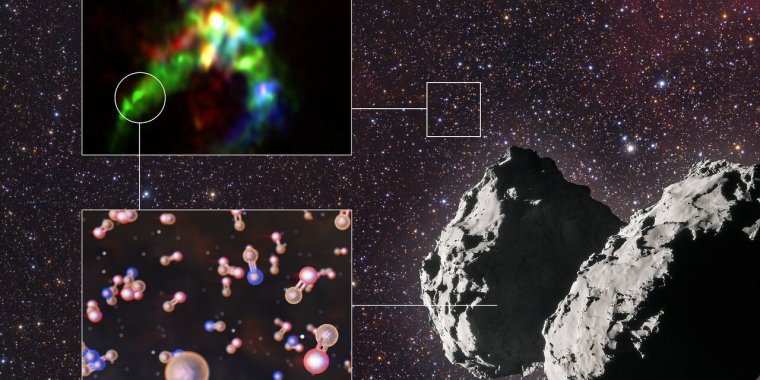| News / Space News |
Astronomers Reveal Interstellar Thread of One of Life’s Building Blocks
Phosphorus, present in our DNA and cell membranes, is an essential element for life as we know it. But how it arrived on the early Earth is something of a mystery. Astronomers have now traced the journey of phosphorus from star-forming regions to comets using the combined powers of ALMA and the European Space Agency’s probe Rosetta. Their research shows, for the first time, where molecules containing phosphorus form, how this element is carried in comets, and how a particular molecule may have played a crucial role in starting life on our planet.

Phosphorus-bearing molecules found in a star-forming region and comet 67P. Photo: ESO
"Life appeared on Earth about 4 billion years ago, but we still do not know the processes that made it possible," says Víctor Rivilla, the lead author of a new study.
The new results from the Atacama Large Millimeter/Submillimeter Array (ALMA), in which the European Southern Observatory (ESO) is a partner, and from the ROSINA instrument on board Rosetta, show that phosphorus monoxide is a key piece in the origin-of-life puzzle.
With the power of ALMA, which allowed a detailed look into the star-forming region AFGL 5142, astronomers could pinpoint where phosphorus-bearing molecules, like phosphorus monoxide, form. New stars and planetary systems arise in cloud-like regions of gas and dust in between stars, making these interstellar clouds the ideal places to start the search for life’s building blocks.
The ALMA observations showed that phosphorus-bearing molecules are created as massive stars are formed. Flows of gas from young massive stars open up cavities in interstellar clouds.
Molecules containing phosphorus form on the cavity walls, through the combined action of shocks and radiation from the infant star. The astronomers have also shown that phosphorus monoxide is the most abundant phosphorus-bearing molecule in the cavity walls.
After searching for this molecule in star-forming regions with ALMA, the European team moved on to a Solar System object: the now-famous comet 67P/Churyumov–Gerasimenko.
The idea was to follow the trail of these phosphorus-bearing compounds. If the cavity walls collapse to form a star, particularly a less-massive one like the Sun, phosphorus monoxide can freeze out and get trapped in the icy dust grains that remain around the new star.
Even before the star is fully formed, those dust grains come together to form pebbles, rocks and ultimately comets, which become transporters of phosphorus monoxide.
ROSINA, which stands for Rosetta Orbiter Spectrometer for Ion and Neutral Analysis, collected data from 67P for two years as Rosetta orbited the comet.
Astronomers had found hints of phosphorus in the ROSINA data before, but they did not know what molecule had carried it there. Kathrin Altwegg, the Principal Investigator for Rosina and an author in the new study, got a clue about what this molecule could be after being approached at a conference by an astronomer studying star-forming regions with ALMA: “She said that phosphorus monoxide would be a very likely candidate, so I went back to our data and there it was!”
This first sighting of phosphorus monoxide on a comet helps astronomers draw a connection between star-forming regions, where the molecule is created, all the way to Earth. (ESO)
YOU MAY ALSO LIKE





